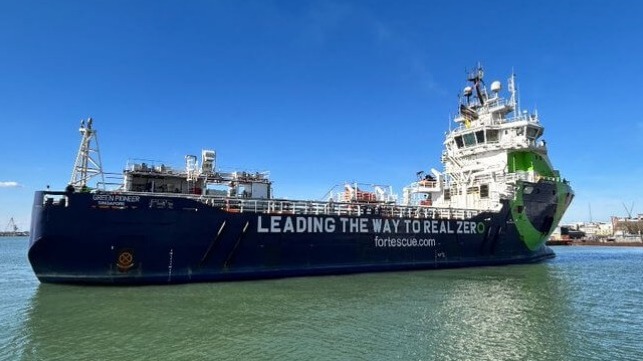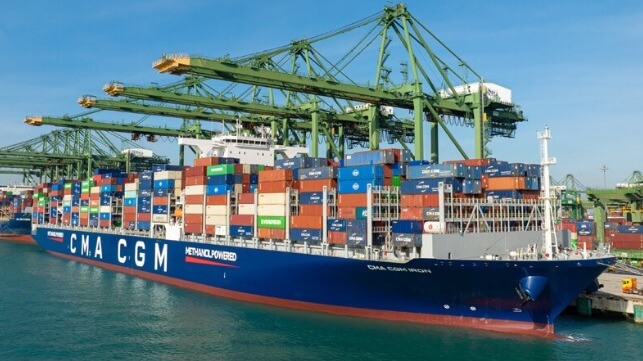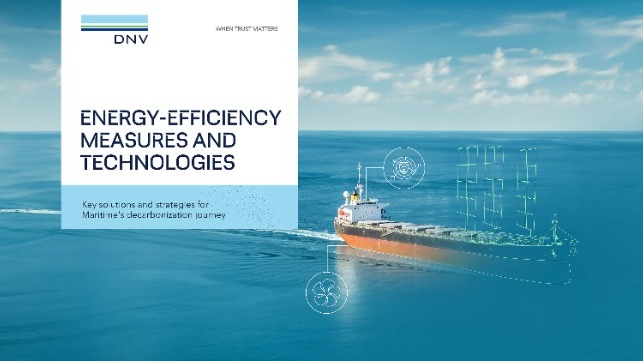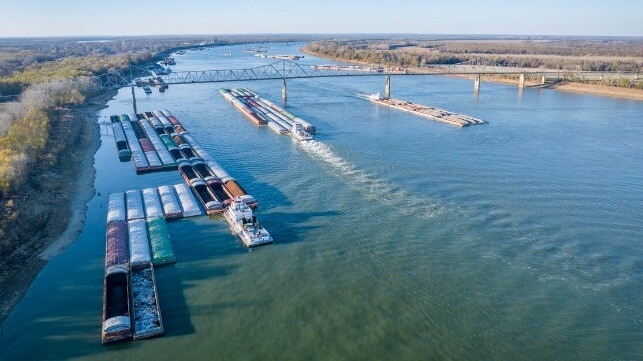ALT. FUELS
Fortescue Brings Ammonia-Powered PSV to UK Ahead of IMO Meetings

With the IMO’s next Marine Environment Protection Committee (MEPC) set to take place in April, Australia’s Fortesce’s marine division, Fortescue Zero, brought its dual-fuel ammonia-powered vessel to London for demonstrations. The company previously showed off the vessel for the first time in Dubai during the UN’s COP 28 in November 2023 and now seeks to highlight ammonia’s potential as the IMO works to set its net-zero policies.
The Singapore-flagged vessel Green Pioneer (3,100 dwt) arrived in the UK on March 1 from Singapore with the company and UK government highlighting it would demonstrate the viability of ammonia as a sustainable marine fuel. Also after being certified in Singapore in the spring of 2024, the vessel will undergo inspections by the UK’s Maritime and Coastguard Agency.
“The MCA will conduct thorough inspections and checks to ensure the vessel’s safety and operational readiness for its onward journey,” said Lars Lippuner, MCA Director of UK Customer Services. “It has been a pleasure working in collaboration with Fortescue to bring this innovative vessel to Europe, and we are excited that the shift to a more sustainable marine fuel and a world’s first is being showcased here in the UK.”
Fortescue acquired an offshore supply vessel, MMA Leveque, early in 2022 from Australia-based MMA Offshore. Built in 2010 in Indonesia, the vessel was originally outfitted with four diesel-electric Cummins main engines. Two of the four engines were converted to be able to use ammonia or diesel for the demonstrations. The first-ever ammonia bunkering took place in March 2024 in Singapore and then a second in May as it completed testing.
Fortescue Executive Chairman and Founder, Dr. Andrew Forrest, said they brought the vessel to the UK to deliver the simple message and highlight the critical message to embrace real zero fuel standards. He called it an opportunity that cannot be missed urging the IMO to fast-track shipping’s move away from dirty bunker fuels.
The UK’s Maritime Minister Mike Kane called the vessel the type of innovation that will drive decarbonization forward. He highlighted the government’s support and efforts to achieve net-zero goals.
To support Fortescue Green Pioneer’s time in the UK, the vessel and team are reported to have been working closely with the Maritime and Coastguard Agency to ensure full compliance with UK regulatory requirements. Port State Control inspections were scheduled for Southampton after the vessel’s arrival. It will then travel to West India Dock in London to showcase its technology and capabilities to key maritime stakeholders, partners, and the public.
The MCA notes that it is currently working with other member states at the IMO to further develop the interim guidelines on the use of ammonia as a fuel. The IMO still must review and finalize standards and then move for adoption. It is seen as a critical step as engine manufacturers move into their final stages of testing for ammonia engines and expect to be ready for commercial deliveries in the near future.
CMA CGM Joins Ranks of Methanol Pioneers Putting First Vessel in Service

The French shipping group CMA CGM recently took delivery of its first dual-fuel methanol containership. While the group continues significant investments in LNG-fueled newbuilds it also recognized the need for diversified sources during this period of transition in the maritime industry.
The new vessel CMA CGM Iron departed Singapore on March 4 bound for the Khalifa port in the UAE on its first voyage. The vessel is joining the route between Ais and the Middle East Gulf region.
CMA CGM ordered 12 methanol-capable vessels from HD Hyundai Samho Heavy Industries in South Korea in 2023. The order was valued at $2 billion with the series due for delivery in 2025 and 2026. Registered in Malta, CMA CGM is saying the container ship is “a new milestone on its group’s path toward net zero carbon by 2050.”
The naming ceremony for the new ship took place on February 17 in South Korea shortly before her delivery. CMA CGM Iron is 146,000 dwt with a capacity of approximately 13,000 TEU. The vessel measures 1,099 feet (335 meters). The sister ships, which will include CMA CGM Cobalt, Argon, Platinum, Mercury, Helium, Krypton, Thorium, Osmium, Silver, Copper, and Gold will be progressively deployed in 2025 and 2026.
.jpg)
CMA CGM Iron is the first of a new class of a dozen methanol-fueled containerships (CMA CGM)
This new class is the latest step in CMA CGM’s effort with the company reporting it has invested nearly $20 billion to order LNG and methanol-powered ships. In 2024, the Group took delivery of 12 new LNG-fueled vessels and was linked yesterday to a new $2 billion order placed in China for another dozen LNG-fueled vessels. The group says that by 2029 it will have 153 ships capable of using low-carbon energies (biogas, biomethanol, and synthetic fuels) in its fleet. CMA CGM reports a total fleet currently of over 650 vessels with orders of nearly 100 new ships.
“In the future, the diversity of technologies and the availability of greener fuels, such as biomethane or biomethanol, will remain a major challenge for the CMA CGM Group and the industry,” the company said last week in its annual financial results report.
Methanol continues to emerge as a fuel while concerns continue about the supply and the cost of the fuel. One key challenge is that it has a lower energy density than other alternatives. In part, this might account for a slower pace for additional orders for methanol-fueled ships. There are also reports within the industry that shipowners have revised building contracts with Alphaliner saying this week that Wan-Hai has approached shipbuilders in South Korea about possibly switching its order for eight 16,000 TEU ships to LNG engines.
While there were 166 new orders in 2024 according to DNV, no methanol-fueled orders have so far been placed in 2025. This compares with 44 orders in the first two months of this year for LNG-fueled vessels.
Overall, the methanol orderbook grew quickly in the past two years with containerships leading the sector. DNV calculates that there are 25 containerships currently in service able to use methanol which has caught up to the product tanker segment. However, the orderbook shows over 300 methanol ships scheduled by 2030, two-thirds are containerships.
DNV Report Helps Shipowners Select Energy-Efficiency Measure & Technologies

[By: DNV]
With increasing regulatory pressure and rising fuel costs, the shipping industry must accelerate decarbonization while ensuring operational and economic viability. Energy-efficiency measures can play a crucial role in reducing fuel consumption and facilitating the transition to alternative fuels as they become available. To help shipowners identify the best solutions for their fleet, DNV has published a report offering a comprehensive overview of currently available energy-efficiency measures and technologies.
DNV’s latest report, Energy-efficiency measures and technologies – Key solutions and strategies for Maritime’s decarbonization journey, provides a comprehensive overview of more than 40 energy-efficiency measures, detailing their fuel-saving effects, cost figures, and suitability for specific ship types. It highlights how these measures can help shipowners meet short- and mid-term regulatory requirements, gain a competitive edge, and ensure profitable operations well into the 2030s and 2040s.
Knut Ørbeck-Nilssen, CEO at DNV Maritime, said: “The decarbonization of shipping is one of our greatest challenges. While transitioning to carbon-neutral fuels is essential, supply and cost remain key barriers. To accelerate this shift, all possible measures must be explored. Energy-efficiency measures can not only cut emissions in the short term but also support the adoption of alternative fuels by reducing overall fuel demand and operational costs. With many such measures available, our report aims to help stakeholders navigate these choices and identify the best solutions for their fleets.”
In the report, DNV explores a wide range of technical and operational measures, detailing cost considerations, suitability for different ship types, and the challenges of combining multiple solutions effectively. Digitalization also plays an important role, and the report offers insights into how data-driven decision-making can enhance fuel savings, while ensuring cybersecurity remains a priority.
DNV’s report outlines a three-step approach for managing decarbonization risks: defining greenhouse gas (GHG) trajectory and goals, assessing pathways for meeting these goals, and developing a fleet decarbonization strategy and plan. It also explores other solutions such as low-carbon and carbon-neutral fuels, biofuels, onboard carbon capture, fuel cells, and nuclear propulsion, evaluating their benefits, challenges, and emissions reduction potential.
Jason Stefanatos, Global Decarbonization Director at DNV Maritime added: “Energy efficiency is key to reducing emissions and enabling low-carbon fuel adoption. While there’s no one-size-fits-all solution, improving onboard efficiency reduces emissions in the short term and accelerates low-carbon fuel adoption in the long term. Every percentage of fuel saved, whether conventional or alternative, translates into significant cost savings. Energy efficieny is becoming critical, and the industry must raise awareness, gain knowledge, and plan ahead.”
The products and services herein described in this press release are not endorsed by The Maritime Executive.
Innovations in Maritime Fluid Technology for a Low-Carbon Future

The maritime industry is transforming due to an emphasis on carbon reductions, technological advancement, and stricter regulations. Operators in both coastal and inland waterways now face the challenge of maintaining reliable, compliant operations while adapting to evolving performance standards, and advancements in fluid technology are helping drive this.
Key Trends in Maritime Fluid Technology
It’s no secret that helping reduce greenhouse gas emissions intensity is a primary goal across the shipping industry. This shift toward lower carbon-intensity fuels and higher engine efficiency presents new challenges for lubricants. This is where investments in renewable base stocks and additive technologies come into play.
Traditionally, vegetable-based Environmental Acceptable Lubricants (EALs) have struggled to match the durability and performance of mineral oils. However, newer synthetic EALs, deliver high-performance attributes including oxidation and wear protection, as well as compatibility with modern equipment materials. These advancements ensure that lubricants can meet both regulatory and operational demands.
Environmental Compliance and Fluid Formulation
Regulatory compliance remains a key aspect of maritime operations. The EPA's Vessel General Permit (VGP) standards require operators to use biodegradable lubricants in certain applications, such as propulsion and hydraulic systems. Although conventional mineral oils are less expensive, they fail to meet these compliance standards and pose significant environmental risks in the event of leaks or spills.
To address these needs, there are now new synthetic, renewable EAL formulations on the market that provide both biodegradability and superior performance. For instance, some formulations even meet stringent VGP biodegradability requirements, breaking down by 60% or more within 28 days.
Unlike earlier generations of EALs, which suffered from short lifespans and incompatibility with seals and polymers, these next-generation products offer improved thermal stability, longer service intervals, and reduced equipment wear. Esters, a popular base for some EALs, demonstrate better heat resistance than vegetable oils but can degrade polymer seals in machinery.
By refining plant-derived base stocks to synthetic quality, there are now solutions that integrate seamlessly with existing equipment. This reduces the risk of breakdowns and minimizes lifecycle costs, helping operators achieve their lower carbon goals.
Balancing Cost, Performance, and Compliance
One of the most common concerns raised by operators is the higher upfront cost of EALs compared to traditional lubricants. However, these costs should be weighed against the potential financial impact of environmental incidents. A single spill or leak can lead to cleanup expenses and regulatory fines far exceeding the investment in compliant fluids. By choosing premium EALs, maritime operators can safeguard both their assets and their bottom line.
Those using VGP-approved lubricants have reported longer oil life and reduced maintenance costs, leading to improved return on investment. Don’t be afraid to reach out to the technical service teams of lubricant providers for help – they are often happy to work closely with you to optimize maintenance strategies, including regular fleet surveys and fluid condition monitoring. These proactive measures help prevent equipment failures, ensuring maximum uptime and efficiency.
Additionally, education is key to ensuring the effective adoption of new lubricant technologies. Many lubricant providers offer a range of resources from industry forums and OEM collaboration to training sessions to help you better understand the benefits of lower carbon intensity fluid technologies.
The Future of Marine Fluids
The maritime industry’s future depends on innovation and helping to advance a lower carbon future. Over the next 5 to 10 years, we anticipate continued advancements in renewable base stocks, additive technology, and regulatory compliance standards. We need to be committed to leading this charge by developing products that not only meet but exceed these requirements with the next generation of marine lubricants.
With its combination of synthetic renewable base oils, high performance, and biodegradability, it sets a new standard in the sector. As maritime operators navigate these challenges, they can rely on new, innovative solutions that enhance both environmental stewardship and operational excellence. Staying ahead of regulatory trends and technological advancements can help you achieve long-term success as the world moves to a lower carbon future.
Ronald Boffa is a Lead Inland Marine Specialist at Chevron.
The opinions expressed herein are the author's and not necessarily those of The Maritime Executive.
No comments:
Post a Comment